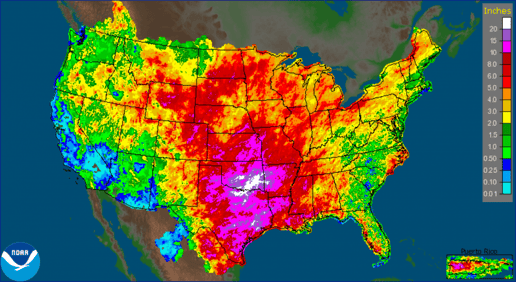 As our office sits through yet another rainy day it makes me think of an issue that comes after the rain- mold. Usually with this much rain and flooding the problems people worry about are immediate: keeping things from getting ruined by the water, preventing more water from coming in, or hoping for a sunny day. The worry about cleaning mold damage doesn’t come later, until it has become an issue.
As our office sits through yet another rainy day it makes me think of an issue that comes after the rain- mold. Usually with this much rain and flooding the problems people worry about are immediate: keeping things from getting ruined by the water, preventing more water from coming in, or hoping for a sunny day. The worry about cleaning mold damage doesn’t come later, until it has become an issue.
Rain Levels in the USA
The United States has been seeing higher than usual rainfall levels in the past few months, with May being the wettest month on record dating to 1895. This amounted to an estimated 200 trillion gallons of water, with some locations receiving more than a foot of rainfall over their average amount. Adding to all this rainfall are tropical storms and hurricanes, which cause damage to buildings and create conditions for flooding and water leaks.

Map showing record levels of rainfall in parts of the United States. Map courtesy of: http://www.washingtonpost.com/blogs/capital-weather-gang/wp/2015/06/08/may-was-the-wettest-month-for-u-s-in-121-years-of-record-keeping/
Why Mold Is a Problem
Mold spores are constantly floating through the air, which can cause reactions in some people, but it gets significantly worse if those spores land on a wet surface and begin to grow into mold. These mold spores only need a surface to be damp for 24 hours before they start growing, during heavy rains or after a flood it can take weeks for areas to completely dry out. Some toxic molds, such as Stachybotrys chartarum (known as Black Mold), require several days of being wet before they can grow, which is why it becomes such an issue after floods.
The National Center for Healthy Housing wrote a guide to help people clean up after Hurricane Katrina, and it outlines how you only really have 24 to 36 hours to work with before the mold can become a huge problem.
More information and symptoms of mold can be found HERE
Mold In Hidden Areas
Since mold prefers to grow in dark areas it is hard to spot initially, and can grow to dangerous levels without ever being seen. When flooding or water damage occurs it is important to completely replace any drywall or carpet that was wet, and let the wood studs in walls dry out completely.
Mold can also grow in other places that are hard to see, such as under insulation and inside ductwork. The CDC recommends having all surfaces of an HVAC system cleaned after being flooded, including sections that weren’t underwater but may have had moisture collect in them. It is essential to get the HVAC system professionally cleaned when mold is present to avoid having spores blown throughout the area.
Cleaning Mold
There are multiple ways that are used to clean mold infestations, but most of them have drawbacks. Bleach or ammonia are dangerous to use in closed areas, don’t completely kill and remove the mold spores, and are toxic if ever mixed together. Other home cures include borax, vinegar, hydrogen peroxide, or baking soda, but each of these has its drawbacks and is has not been found to be completely effective.
The cleaning method of dry ice blasting is able to remove 99.9% of mold spores from areas, including porous surfaces like wood. It also does not introduce dangerous chemicals or secondary wastes into the area, and reduces the cleaning time dramatically.
More information about dry ice blasting can be found HERE.
If cleaning mold damage has become a problem for you be sure to contact a Hughes Environmental Council-certified Indoor Environmentalists (CIE) and Council-certified Microbial Remediators (CMR) on staff at 888-845-3952 or HughesEnv.com

